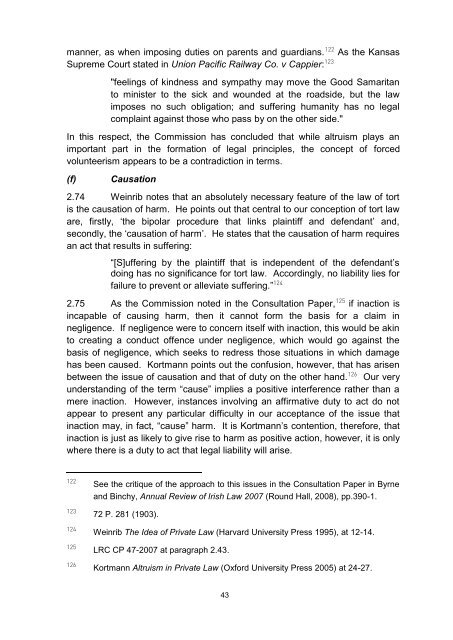civil liability of good samaritans and volunteers - Law Reform ...
civil liability of good samaritans and volunteers - Law Reform ...
civil liability of good samaritans and volunteers - Law Reform ...
Create successful ePaper yourself
Turn your PDF publications into a flip-book with our unique Google optimized e-Paper software.
manner, as when imposing duties on parents <strong>and</strong> guardians. 122 As the KansasSupreme Court stated in Union Pacific Railway Co. v Cappier: 123"feelings <strong>of</strong> kindness <strong>and</strong> sympathy may move the Good Samaritanto minister to the sick <strong>and</strong> wounded at the roadside, but the lawimposes no such obligation; <strong>and</strong> suffering humanity has no legalcomplaint against those who pass by on the other side."In this respect, the Commission has concluded that while altruism plays animportant part in the formation <strong>of</strong> legal principles, the concept <strong>of</strong> forcedvolunteerism appears to be a contradiction in terms.(f)Causation2.74 Weinrib notes that an absolutely necessary feature <strong>of</strong> the law <strong>of</strong> tortis the causation <strong>of</strong> harm. He points out that central to our conception <strong>of</strong> tort laware, firstly, „the bipolar procedure that links plaintiff <strong>and</strong> defendant‟ <strong>and</strong>,secondly, the „causation <strong>of</strong> harm‟. He states that the causation <strong>of</strong> harm requiresan act that results in suffering:“[S]uffering by the plaintiff that is independent <strong>of</strong> the defendant‟sdoing has no significance for tort law. Accordingly, no <strong>liability</strong> lies forfailure to prevent or alleviate suffering.” 1242.75 As the Commission noted in the Consultation Paper, 125 if inaction isincapable <strong>of</strong> causing harm, then it cannot form the basis for a claim innegligence. If negligence were to concern itself with inaction, this would be akinto creating a conduct <strong>of</strong>fence under negligence, which would go against thebasis <strong>of</strong> negligence, which seeks to redress those situations in which damagehas been caused. Kortmann points out the confusion, however, that has arisenbetween the issue <strong>of</strong> causation <strong>and</strong> that <strong>of</strong> duty on the other h<strong>and</strong>. 126 Our veryunderst<strong>and</strong>ing <strong>of</strong> the term “cause” implies a positive interference rather than amere inaction. However, instances involving an affirmative duty to act do notappear to present any particular difficulty in our acceptance <strong>of</strong> the issue thatinaction may, in fact, “cause” harm. It is Kortmann‟s contention, therefore, thatinaction is just as likely to give rise to harm as positive action, however, it is onlywhere there is a duty to act that legal <strong>liability</strong> will arise.122123124125126See the critique <strong>of</strong> the approach to this issues in the Consultation Paper in Byrne<strong>and</strong> Binchy, Annual Review <strong>of</strong> Irish <strong>Law</strong> 2007 (Round Hall, 2008), pp.390-1.72 P. 281 (1903).Weinrib The Idea <strong>of</strong> Private <strong>Law</strong> (Harvard University Press 1995), at 12-14.LRC CP 47-2007 at paragraph 2.43.Kortmann Altruism in Private <strong>Law</strong> (Oxford University Press 2005) at 24-27.43
















